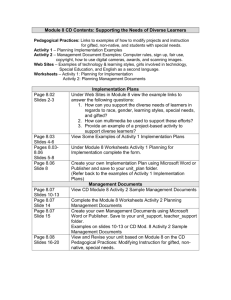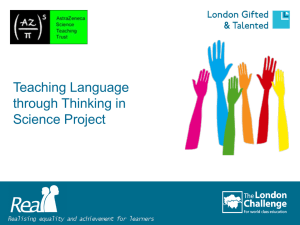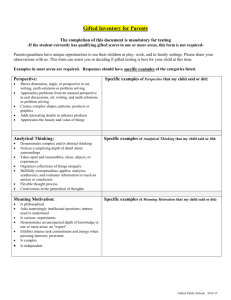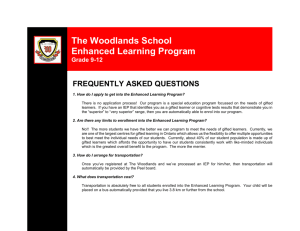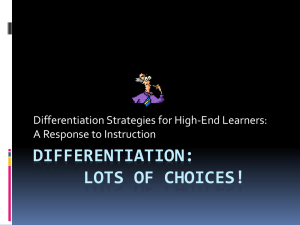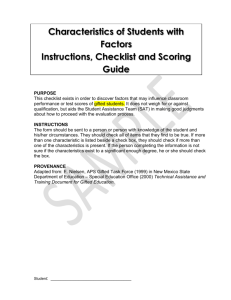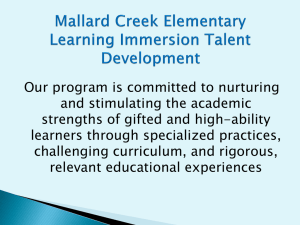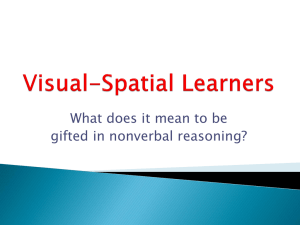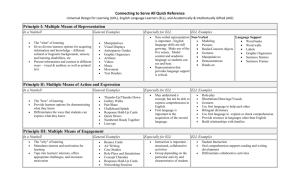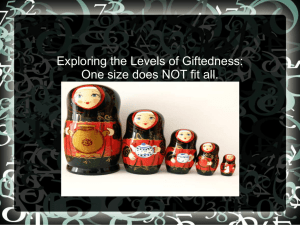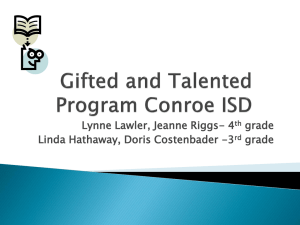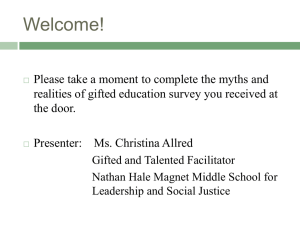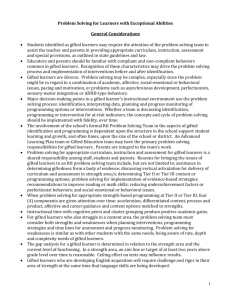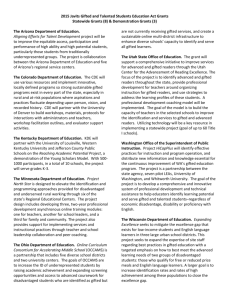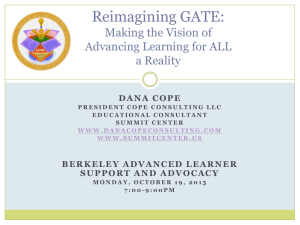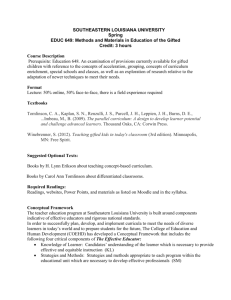Talent Development
advertisement
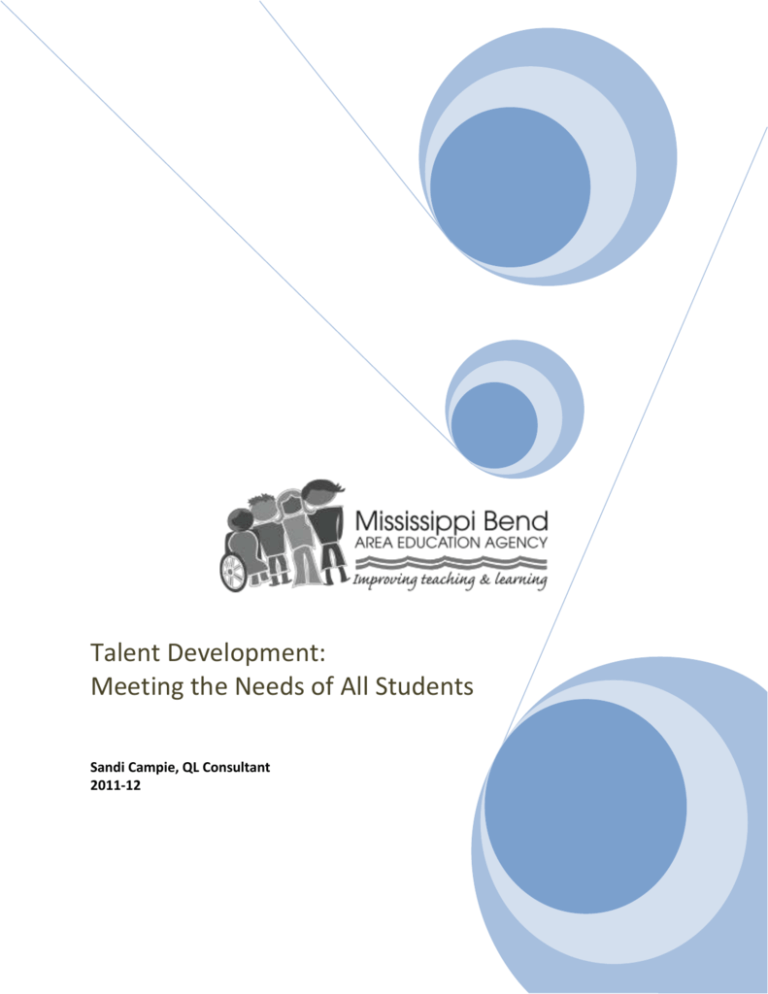
Talent Development: Meeting the Needs of All Students Sandi Campie, QL Consultant 2011-12 Good for All Students but Essential for High Ability Learners High level of sophistication of ideas Opportunities for extensions that challenge the most able learners Potential for tailoring content to individual needs of high ability learners Use of higher order thinking skills is integral to the lesson (analysis, synthesis, and evaluation) Organization of content by key issues or themes Less emphasis on basic skills once mastery level has been demonstrated A sufficiently high level of abstraction encouraged Opportunities for student exploration based on interest Opportunities for products that are: Open-ended Advanced 2011-12 MBAEA9 5 ASSUMPTIONS ABOUT GENERAL CURRICULA General school curriculum, as it is currently operationalized, is insufficient and inappropriate for gifted learners. (Iowa Core Curriculum will better address the needs of gifted.) General school curriculum needs to be modified for the gifted by reorganization rather than just adding or deleting. (Every child deserves to learn.) Appropriate differentiation of the curriculum in one area and at one grade level affects all areas and levels. It needs to be viewed as a long-term process rather than a fragmented program. (Individual plans for more than one year are necessary.) A curriculum plan for the gifted must be written down and communicated appropriately within a school district. (Each area where there is a need should have something in place to address the student needs.) Curriculum that is planned for gifted learners in schools can benefit a wider spectrum of students. (Some students with higher than average ability may have enough interest in a topic to perform at high levels. Students with products or performances of high quality can stimulate others to higher quality.) Van Tassel-Baska, J. (1994). Comprehensive curriculum for gifted learners. Boston, MA: Allyn & Bacon. Van Tassel-Baska, J. (1992). Planning effective curriculum for gifted learners. Denver, CO: Love Publishing (Material in italics added by Sandi Campie) 2011-12 MBAEA9 CHARACTERISTICS OF GIFTED CHILDREN CHARACTERISTICS Extreme Curiosity Involved in Explorations Is often a self-starter and pursues individual interests. Learns rapidly and easily Creative and Inventive Like new ways of doing things Expresses self creatively High verbal ability Enjoys words, languages, reads a great deal Uses words in a meaningful way Good sense of humor Wide variety of interests Versatile student Good problem solver Critical thinker Sensitive, empathetic for others Grasps underlying principles and can easily make generalizations Strong sense of justice 2011-12 MBAEA9 POSSIBLE TROUBLE AREAS CURRICULUM IDEAS Knows a little bit about many things but may not have a depth of knowledge about any one topic. Always puzzling over things and ideas. Often a challenge to the teacher because of questions, and contributions to class. Often frustrated with lack of activity or meaningless assignments outside of interest area. The danger is that educators often assume they will “get it on their own” and do not strive to differentiate curriculum. May resist interruption. Off the wall ideas and comments. Easily bored with dull routine or “correct ideas”. Experiments, open-ended questions, trivia games, independent study, mentors, seminars. Threat to teacher and peers (large vocabulary, expression, reading interests, breadth of information). Can talk around problems and lack of knowledge. Uses it at the wrong time. Distracting to class. Dry wit may seem sarcastic, some humor may seem immature or “attention getting” Already knows much of the content. May be involved in so much he does not do anything well. May be a “C” student. May be disorganized. May be depended on by other class members. Easily frustrated when group has difficulty with problem. May appear bossy. May offer other solutions and appear never to accept the “final decision”. Has to find things out for herself. Has difficulty accepting the illogical. Needs emotional support. Often gullible, needs for group to run smoothly. Challenges teachers to know content. Frustrated with facts and drill. Often requires advanced material. Always ready to take sides and fight for a cause. Often evaluates and makes judgments about people, ideas, or events. Independent study, mentors, real audiences, long-term assignments, research skills. Creative writing, dramatics, group work, open-ended projects, CPS, study of creative people. Debates, word games languages, wide variety of books, challenge. Group work, creative writing, creative dramatics, encourage students to look for humor, and to express humor. Mentors, independent study, broad reading patterns, realistic goals, variety, computers. CPS, problem-based learning, examine problems in content, school organizations, cooperative learning. Experiments, open-ended questions, group interaction, seminars. Service projects, group dynamics, examine emotions of people and events in content. Make content personal. Teach in-depth, problem-based learning, abstract concepts, longterm assignments. Current events, problem solving, group interaction, discussion. CURRICULUM/INSTRUCTIONAL MODELS FOR THE GIFTED Van Tassel Baska, 1994 CONTENT Fast Paced Proficiency based Content acceleration Proficiency based Diagnostic-prescriptive approach Curriculum is compressed Organized by intellectual content Teacher as facilitator PROCESS/PRODUCT In-depth on selected topics Product based Resource oriented Organized around scientific or other process model Collaborative Enrichment oriented CONCEPT Epistemological-systems of knowledge and how we think about knowledge Aesthetics based Discussion approach Organized by themes and ideas Socratic method Dominant emphasis is the world of ideas Example: Advanced Placement Courses Example: Renzulli’s Enrichment Triad Model Example: Junior Great Books, Man— Course of Study, William & Mary Units Research Indicates: This type of proficiency based model is most effective. Research Indicates: Process/product models linked to content are more effective. Research Indicates: Is highly effective in increasing student achievement. 2011-12 MBAEA9
